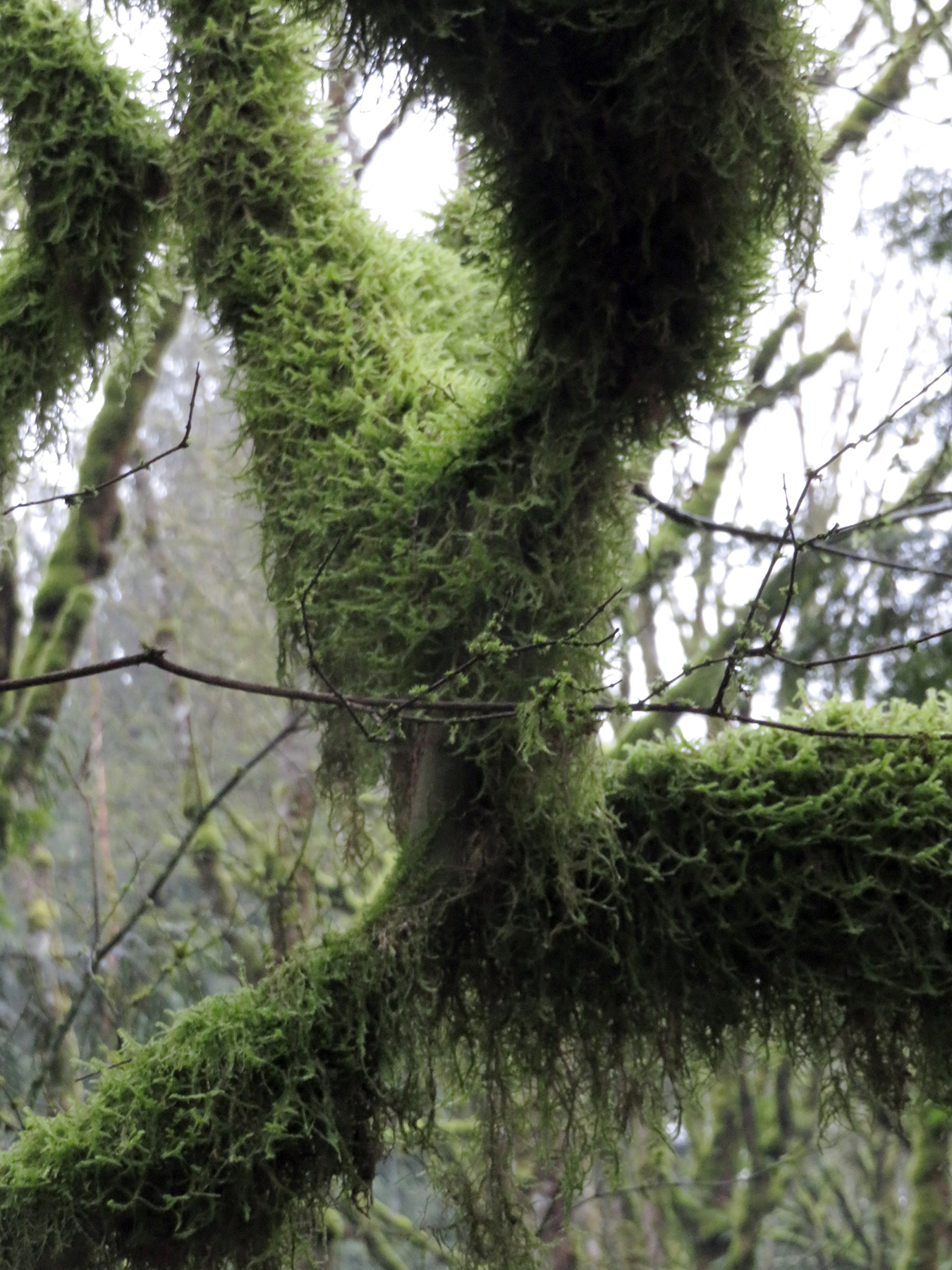And when thou art weary I’ll find thee a bed
Of mosses and flowers to pillow thy head; – John Keats To Emma (ca. 1815)
I cherish this couplet, find the thought of a pillow of moss appealing (although currently you might want to bring a waterproof plane before you sit down…)

And since I want to start the week with making you less weary, the couplet is the perfect fit. (Which cannot be said for the rest of the poem, which closes with this: So smile acquiescence, and give me thy hand,
With love-looking eyes, and with voice sweetly bland. No sweetly bland voice here, googly eyes and/or acquiescence…. but lots of intentions to get your spirits up.

Moss it shall be: for one, because it shines, glimmers, glows in abundance right now, greenest, most brilliant green in those watery woods (Tryon Creek). Secondly because it gives me the opportunity to cite Wikipedia’s color page where I found this gem: Green is common in nature, especially in plants.
I hope you spill your coffee laughing. I did. Or maybe you need to know German, where the equivalent of nature is green: Wir gehen ins Grüne…

Let’s proceed to name the biological greens:

We are subsequently told that:
Moss green is a tone of green that resembles moss. Who would have thought.
Tidbit: Moss is practical. It used to be the diaper of millennia of babies – Native Americans stuffed spagnum in bags with which they swaddled their children, the Inuit used moss inside sealskin covers, and Mongolians used fur sacks stuffed with moss to carry the young. Biodegradable, too. It was used as antiseptic bandages to treat the wounds of thousands of WWI soldiers, when the Allied forces ran out of cotton bandages. (Link is to a fascinating article in the Smithsonian.)

I have written a bit more seriously some time back on moss and lichen, with a focus on the latter. If memory serves me right, we talked about rootless Bryophyta, which is the botanical name for moss, attaching themselves to their environment via hairy protrusions called rhizoids, take water and air in to create their food through photo synthesis.

Today I am more interested in why moss appears so intensely luminous when you hike through the forests during these dark, rainy days.
It has to do with a process called the Purkinje effect, or Purkinje shift, named after the Czech anatomist Jan Evangelista Purkyne, who proposed it at the beginning of the 19th century. It is the tendency for the peak luminance sensitivity of the human eye to shift toward the blue-green end of the spectrum at low illumination levels. Simply put, we have two main receptor types in the retina, the rods and the cones. The former are more light sensitive, but pretty much worthless for distinguishing color. They take over when it gets dark, because the cones, which are color-sensitive, fire best only when there is lots of light.

When light is scarce, at dawn and dusk, but also on these cloudy, rainy days in the woods, the reds, processed by cones now starved of stimulation, will appear duller and duller. The greens take on a contrasting brightness, because the rods take over. Voilà, iridescent green.

Before we all get too happy basking in that glow, here is the dark side of moss: half a billion years ago, when Bryophyta first appeared on land, they plunged earth into an ice-age and caused mass extinction of ocean life. Before you freak out, it took them 35 million years to do so, and they might just be the antidote to global warming if we could only wait that long.

Nonetheless, then it was a catastrophe – moss secretes a wide range of organic acids that can dissolve rock, and the altered rock can then suck CO2 out of the atmosphere. Sharp reduction in carbon dioxide levels ensues – here comes the ice. (For a more detailed account, go here.)

Reminder to self: this was supposed to cheer, not make more weary. Music to the rescue:
So here is a ditty from the 50s – Ja ja im Moos, da ist was los – well, well, things are hopping in the moss…..

and one a little older: Brahms says it all about the cool forest.







Martha Ullman West
Lush, tactile photographs, make me feel the damp moss on the palms of my hands, make me wish there were some way to make office chair cushions from moss to cradle my aching hamstrings, and the lines from Keats, some of my favorites. And yes I choked on my coffee; you did make me laugh on a day when I don’t much feel like it. Danke, Friderike Heuer, danke.
Sara Lee
Nice to make the acquaintance of the Purkinje Effect and, even more, to see the lovely photos illustrating it!
Philip Bowser
I love all the new information you bring to my desktop!